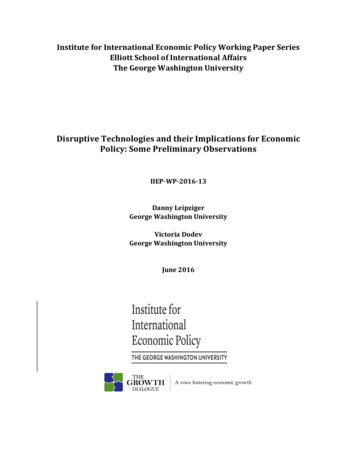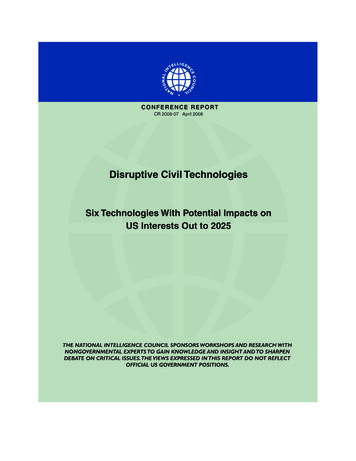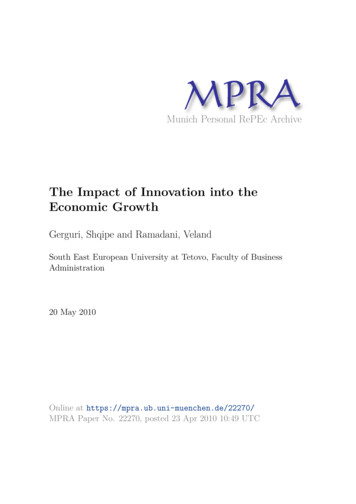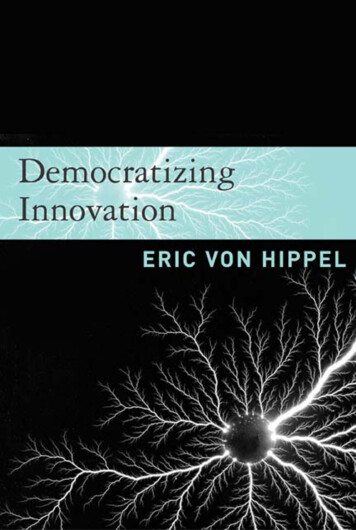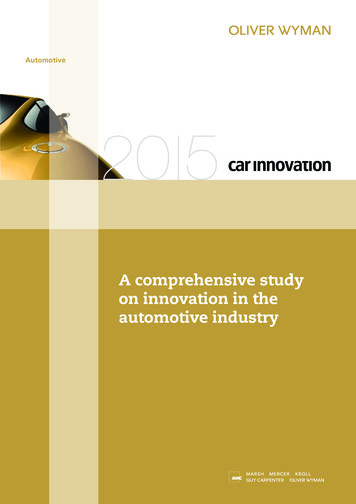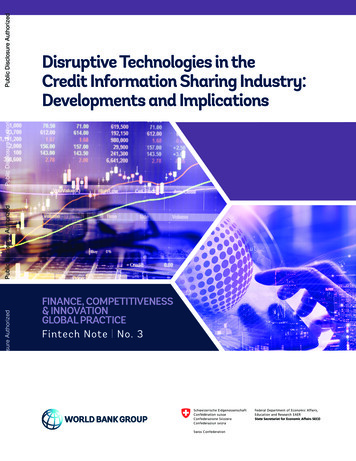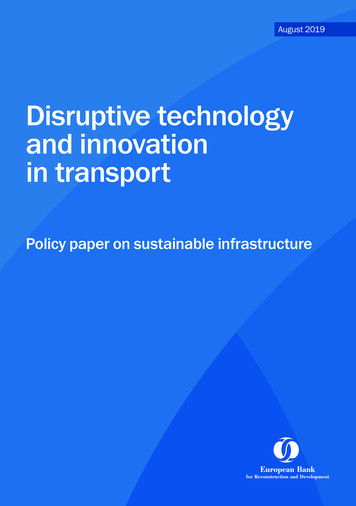
Transcription
August 2019Disruptive technologyand innovationin transportPolicy paper on sustainable infrastructure
Executive summaryA key objective of the European Bank forReconstruction and Development (EBRD),especially in the transport sector, is to supportthe promotion of innovative new technology in theeconomies where the Bank operates to improvecompetitiveness and provide demonstrationeffects. The purpose of this paper is to provide anoverview of the current state of the market andopportunities for the implementation of a rangeof (disruptive) digital technologies capable ofrevolutionising the transport sector in the EBRDregions. These technologies include: the internet of things (IoT) – a system of objects,processes, data and people connected with eachother via sensors, and controlled remotely usingthe internet big data – complex data characterised by highvolume and requiring the use of advancedanalytics for processing artificial intelligence (AI) – computer sciencewhich enables machines to function likea human brain drones – unmanned aerial vehicles (UAVs) orflying robots.The paper outlines a range of digital technologiesand concepts (Section 2), introduces varioustechnology application areas with supporting casestudies and cost-benefit analysis (Section 3) anddiscusses a policy roadmap for their successfulimplementation (Section 4).The summary of the technologies presented inSection 2 demonstrates that IoT, big data and AIdo not operate in isolation but instead representhighly complementary technologies. Big data iscollected most effectively using IoT systems anddrones and then processed most efficiently usingAI algorithms and optimisation techniques. Themain applications of these particular technologiesin transportation focus around demand forecastingand traffic optimisation resulting in better trafficmanagement, asset management, travel planningand operation of autonomous vehicles (AVs). ThePolicy paper on sustainable infrastructurekey challenge in the development of the identifieddisruptive technologies and their applications willbe their successful integration into new businessand governance models, maximising their combinedbenefits to support the end goal.The four applications of the disruptive technologiesthat Section 3 reviews in detail are as follows: Traffic management using intelligent transportsystems (ITS) – using new technologies to predictfuture traffic demand more accurately and optimiseroad networks accordingly, providing a wide rangeof social and economic benefits, including reducedcongestion and pollution, improved safety andtravel experiences for all road users. Personal travel planning and public transport –analysing available information on travel demandand travel patterns of the population, to facilitatethe optimisation of planning, programming andoperation of public transport systems, as well asimproving personal journey planning for the public. Autonomous and connected vehicles formobility – developing applications for AVs whichcan contribute to increased safety, a better userexperience, economic savings and reductionsin congestion, by facilitating car sharing and“mobility as a service” (MaaS). Unmanned aerial vehicles/drones formonitoring - using technology to revolutionisethe way we undertake asset management,maintenance and inspections (bridges, tunnelsand construction sites) and providing an efficientmeans to deliver packages (logistics).These technology application areas were reviewedin the context of their contribution to the followingpolicy objectives: (1) transport efficiency, (2) safety andsecurity, (3) environment and climate change and(4) socio-economics. From the analysis of these policyobjectives we concluded that the technology applicationareas which have the most profound (disruption)potential impact were new smart mobility (AVs/MaaSand drones) and intelligent transport systems (ITS), eachrequiring and leveraging different digital technologies.August 20191
The key challenge in the development of theidentified digital technologies and their applicationswill be to integrate the business and governancemodels for new mobility technologies, services andsystems successfully. The following challenges arecritical to this process: Harmonising existing and new policies related tothe legal framework for use and operationalisationof such technologies. Facilitating interoperability and data sharing. Promoting vehicle-to-infrastructure (V2I) andvehicle-to-vehicle (V2V) communication. Ensuring data security and addressing risksharing/liability concerns.2August 2019 Identifying requirements for facilitating necessaryenabling “public” infrastructure and forms ofeconomic regulation to enable widespreadadoption. Developing cost-benefit analysis methodologiesand the supporting evidence base to promoteadoption. Launching analytical work and developinginnovative operating models. Developing integrated mobility systems. Sharing data and digital infrastructure. Supporting capacity-building, education andawareness-raising.Disruptive technology and innovation in transport
tureBackgroundEconomics of new technology552.6Disruptive technologies102.1.2.2.2.3.Internet of things – a data collection and management toolBig data – the dataArtificial intelligence – a data tool for processingcomplex datasets2.4. Drones – an alternative data collection and exploitation toolfor monitoring101112143.Applications in transport163.1.Traffic management using intelligent transport systemsOverviewEnablers, barriers and opportunitiesCost-benefit analysisCase study – “Talking Traffic” in the NetherlandsCase study – City parking1616171820213.2.Personal and public transport travel planningOverviewEnablers, barriers and opportunitiesCost-benefit analysisCase study – Personal travel planning in Perth, AustraliaCase study – Public transport in Singapore2323232425263.3.Autonomous and connected vehicles for mobilityOverviewEnablers, barriers and opportunitiesCost-benefit analysisCase study – CAVs on a freeway in Antwerp modelling studyCase study – Port of RotterdamCase study – Autonomous vehicles (providing mobility as a service)27272729333334 Policy paper on sustainable infrastructureAugust 20193
3.Applications in transport (continued)003.4.Unmanned aerial vehicles/drones for monitoringOverviewEnablers, barriers and opportunitiesCost-benefit analysisCase study – Amazon Prime AirCase study – Elios indoor drone for bridge inspection in Minnesota3535353637394.Policy roadmap404.1.Policy objectivesTransport efficiency policy objectiveSafety and security policy objectiveEnvironment and climate change policy objectiveSocio-economic policy objective40404040414.2.Policy recommendations to assist with barrier removalBarrier 1: Legal and regulatory frameworkEnabling policy 1: Harmonising existing and new policiesBarrier 2: Data fragmentation and multiple platform developmentEnabling policy 2: Facilitating interoperability and data sharingBarrier 3: Security, insurance and privacy concernsEnabling policy 3: Ensuring data security addressing risksharing/liability concernsBarrier 4: Prohibitive cost or lack of economic and financialevidence of return on investmentEnabling policy 4: Developing cost-benefit analysis methodologiesand the supporting evidence base414242424243Cross-cutting issues and opportunities434.3.434343Bibliography47Annex A. Policy objectives51Glossary of terms524August 2019Disruptive technology and innovation in transport
1. Introduction1.1. ObjectivesThese technologies were selected because:One of the EBRD’s key medium-term priorities is“digitisation and digital development”. An importantaspect of this objective is the promotion of newtechnology and innovation that can improve thecompetitiveness of key sectors and businessesin the EBRD regions. The Bank is now consideringa range of new technologies and innovations thatare being developed and adopted in many partsof the transport sector. It seeks to understandthe opportunities for EBRD clients to adopt andimplement such technologies, including overcomingpotential barriers to entry and adoption, with theBank’s support. their technological applications have specificrelevance to the transport sector they have potential to provide benefits fromstructural change, through addressing congestionand pollution to improved safety and a wide rangeof social and economic benefits they have the most potential to revolutionise howwe live, work and travel in the next 10-20 years they primarily rely on the use of digital technology they have active programmes of implementationwith test programmes in Europe and in Central AsiaThis paper provides an overview of the currentstate of the market and opportunities for theimplementation of specific digital technologies in thetransport sector. It discusses a range of potentialapplication areas including an assessment of thepotential costs and benefits of digital technologiescapable of “disrupting” the transport sector. As such,the paper will be of direct interest to the EBRD’s incountry transport teams, but also to municipalitiesand regional/national transport authorities,illustrating the potential (and successful) applicationof selected disruptive technology in differentcontexts within the transport sector, and a roadmaptowards leveraging such technologies better. Thefollowing technologies are introduced and discussedin the context of the transport sector: Internet of things (IoT) – system of objects,processes, data and people connected with eachother via sensors, and controlled remotely usingthe internet. Big data – complex data characterised byhigh volume and requiring the use of advancedanalytics for processing. Artificial intelligence (AI) – computer sciencewhich enables machines to function like a humanbrain. Unmanned aerial vehicles (UAVs/drones)or flying robots.Policy paper on sustainable infrastructureConversely, the following technologies, while theyare very relevant to transport and have the potentialto significantly disrupt the sector, are not discussedin detail. This is because they are deemed to relyless on the digital transformation of the fourthindustrial revolution, and would require engineeringtransformation to be fully captured by the EBRD policyand business model. Further information is availableelsewhere on: electric vehicles (EVs) advanced materials energy storage technologies (for example,lithium batteries) advanced robotics and manufacturing.1.2. StructureThe structure of this paper is as follows:Section 2 provides a summary of different digitaltechnologies and concepts, covering (1) internetof things, (2) big data, (3) artificial intelligence and(4) drones. These technologies are summarised interms of potential application areas, components,barriers to implementation, technology and policyenablers and opportunities for further developmentand implementation.This section provides a qualitative description ofthe various technologies considered in this paperand a discussion of areas of commonality andcomplementarity. Indeed, many of the technologiesconsidered here are typically applied in combinationAugust 20195
as technology stacks. This is because cost-benefitinformation is not readily available for discretetechnologies, but rather for areas where thesetechnologies, when applied in combination, can yieldsignificant economic and environmental benefits.In Section 3 we introduce different applicationareas, related to the transport sector, to help frameeach of these technologies, focusing on theirpotential impacts and implications. We exploreseveral case studies for each of the applicationareas from Europe, Central Asia and elsewhere,together with information on the costs and benefitsof those applications and specific schemesimplemented around the world.These case studies provide practical examplesof some of the challenges and opportunitiesassociated with the implementation of thesetechnologies, and an outline of their disruptionpotential. After reviewing the most prominentdisruptive technologies and potential applicationareas in transport, we identified several areas ofpublic policy that might warrant further examination.This is discussed in more detail in Section 4.A roadmap for implementation is presented,comprising a range of applications that can buildon these disruptive technologies, as well aspotential barriers, bottlenecks and opportunities.1.3. BackgroundTraditional methods of overcoming critical transportand infrastructure challenges are increasinglysubject to technology-based disruptions, creatingnew opportunities. We are now in the fourthindustrial revolution – but this one is happeningmuch faster than any of its predecessors.The accelerating pace of technology diffusionand its updates, the convergence of multipletechnologies towards human-centric goals, orcommon applications, and the emergence of globalplatforms are disrupting traditional transport andinfrastructure development models.In transport, demand continues to grow each year,with Europeans, on average, travelling around35,000 passenger kilometres per year; with a clearmajority (64 per cent) of these trips being made by6August 2019car. However, the situation is changing rapidly: since2002, the number of kilometres driven per person hasfallen by 8.5 per cent (Deloitte, 2015). Meanwhile, useof public transport has increased. This trend suggeststhat urban residents are becoming more likely toconsider new ways of travelling and to move awayfrom the traditional car ownership model in favour ofnew forms of transport such as car sharing, electricvehicles, autonomous cars and mobility-as-a-service(MaaS) solutions (Deloitte, 2015).The past 100 years have also been characterisedby significant growth in car ownership, which hasbeen linked with global drivers of suburbanisationas well as increasing incomes and consumerpurchasing power. The proportion of the globalpopulation living in urban areas continues torise faster than the capacity of roads and publictransport. The pressure on transport infrastructureis significant and cannot be resolved by simplybuilding more infrastructure. New, innovativesolutions and approaches are required to addressthese problems. The use of new digital technologiesis a key part of addressing this challenge and canhelp to ensure more efficient and sustainable useof existing infrastructure. At the same time, it canencourage the public to abandon their cars in favourof walking, cycling and shared mobility solutions(Webb, 2019).These new forms of transport rely increasingly onexploiting the use of digital technologies, which arerevolutionising the way we travel and communicate.The ability to collect vast amounts of data (“bigdata”) and process it in real time using advancedanalytics and AI will allow us to predict transportdemand better and, as a result, improve our abilityto manage existing infrastructure. Ensuring thatassets are connected and communicate with eachother through internet-of-things protocols andplatforms will provide new ways to organise traffic,travel and logistics, while permitting the remotecontrol and management of assets and networks.The use of robots, such as drones, is alreadyrevolutionising how we manage our assets andundertake infrastructure inspections and surveys,as well as supporting logistics and deliveries ofconsumer goods and services in many establishedand emerging global markets.Disruptive technology and innovation in transport
The digital age has the potential to bring with ita range of disruptive technologies. Indeed, the paceand the scale of the changes is expected to increasedue to the rapid development in digital technologies.In the past, disruptive technologies would have beenviewed as unknown and unproven, often consideredimpractical for real-world application. In manycases these disruptive technologies would displaceestablished firms in existing markets. For example,mainframe computer manufacturers in the 1970sand 1980s underestimated the potential demandfor personal computers. As a result, companies likeApple and Microsoft disrupted the market with theirnew products, while major manufacturers dismissedpersonal computers and overlooked a market thatdid not yet exist (Baker et al., 2016).Today the term “disruptive” is often used to describetechnological advancements which are new, evolverapidly and have a significant impact on how welive and work, as well as on our economy. To ensurethat society is ready for these new technologies,governments, policymakers and lawmakers willneed to gain a good understanding of how the futureis going to unfold and make the right investmentdecisions in infrastructure and education so thatsocieties continue to prosper. In today’s society,digitisation and disruptive technologies such asbig data, IoT, AI and drones have the potential tochange the way the transport sector is organisedand managed, paving the way for new services andbusiness models.Economics of new technologyThe transformative nature of disruptive technologiesmakes their economic and financial analysischallenging. By definition, disruptive technologiesmake more fundamental changes and affect deeperstructures – changing the way existing marketsoperate, creating new players and displacing old ones.The analysis of their impacts requires a correspondingeconomic and financial methodological approachthat considers broader outcomes than those typicallyapplied to transport projects and investment.The types of disruptive technologies proposed herehave a wide range of potential applications andimpacts across society generally. Furthermore,changes due to the deployment of, for example, bigdata solutions can have significant implicationsacross a range of sectors at once. As such, thesetechnologies change the context for transport as wellas transport itself and result in a changing economicand financial landscape. In the World EconomicForum’s study Deep Shift: Technology Tipping Pointsand Societal Impact (20), three of the technologiesconsidered are identified as the subject of “tippingpoint” considerations – big data for decisions(expected to be common by 2023); driverless cars(by 2026); artificial intelligence and decision-making(also by 2026). For these, cost-benefit analysis is onlya partial guide to their feasibility as the structuralchanges they both cause and require depend on awider range of factors.For the transport sector, the economic impactsof new technology will occur through severalmechanisms affecting the demand and supply sidesof the economy: (a) reducing the need for travelthrough substitution; (b) improving the efficiencyand convenience of travel by creating new modes,improved route planning, more efficient vehicles,and in vehicle services and so on; (c) improving theefficiency of infrastructure construction, operationand management; (d) improving the efficiency oftransport operators and other businesses (throughmore competition, new services and new marketstructures); and (e) externalities such as reducedemissions, productivity gains, better information forpublic planning and so on.Policy paper on sustainable infrastructureAugust 20197
The increasing capability of virtual technologieswill reduce the need to travel by allowing remoteobservation and communication, but will alsocontribute to changes in the relative economicvalues of both new and old goods and services,changing incentives for travel and transport. Closelyrelated to changes that affect overall demand arechanges that are fundamental to a certain subsector of the transport network. A clear exampleis the retailer Amazon’s proposed use of dronesfor “final mile” delivery to customers which wouldcompletely substitute an existing part of the limitedcapacity of the current terrestrial distribution system.Cost-benefit analyses of these technologies showthat their economic viability is often clear, but theirdevelopment is inhibited in practice by many barriersto market developments (detailed for each technologyand application in the next section of this report).These barriers mainly fall into three categories – lackof transparency over the potential benefits of thetechnology; the distribution of costs and benefits,which may mean that the benefits are not capturedby those bearing the costs; and regulatory barriersthat prevent the adoption of new technology due,for example, to perceived safety risks.For instance, at the technical level, the inabilityto capture and use relevant data from multiplestreams generated by different systems (ITS or IoT)is the result of several organisational, technicaland commercial barriers. In some cases, a lackof understanding of the potential to use data hasled to a failure to invest in deploying tech-enabledsolutions. But there are also technical challenges,including finding efficient ways to transmit and storedata. The most fundamental challenges are in datatransmission and storage. Many IoT applicationsare deployed on remote or mobile equipment.Real-time transfer of all the data being generated bythe sensors on aircraft engines would require morebandwidth than is currently deployed. If data can becollected and stored, the next obstacle is aggregatingit in a format that can be used for analysis. Limitedstandardisation of data means that substantialsystems integration work is needed to combine datafrom multiple sources. This challenge is accentuatedby connectivity and storage challenges.8August 2019Issues of data ownership within and acrossorganisations can complicate aggregation. Ownersof data from one system might not find it in their owncommercial interest to have their data combinedwith data from other systems (see website link 23at the back of this report). Another example liesin the provision of infrastructure that often is orhas aspects of natural monopoly. It is complex todevelop solutions using disruptive technologiesthat address this, are timely and coordinated, andpermit the benefits of competition. With commonand widespread infrastructures in place, such asroadside or in-vehicle sensors, a range of valueadded services becomes feasible. However, theneed for, and revenue generated from, any oneservice may be insufficient to cover the costs,thus making the implementation of risk-sharingarrangements and associated financing structuressubstantially more complex.In the construction industry, developers inworksite industries are working on two potentialapplications that are too nascent to reach theirmarket potential today, and present too manybarriers for development at this stage: fully roboticworksites and 3D printing of replacement partson-site. Given the labour intensity, unpredictabilityand danger of some worksite environments, beingable to remove employees from the site entirelywould offer substantial productivity and safetybenefits, particularly for assets that are difficultto reach. Many barriers to full automation remain,including the need for more sophisticated roboticsand safety concerns about unmanned operations(especially for bridges and tunnels). The ability to 3Dprint replacement parts on demand could greatlyreduce downtime caused by equipment failure andcould raise asset utilisation and output. However,this would require equipment that produces partsthat meet performance standards. If this challengecould be resolved, worksites would be able to reducesubstantially the cost of carrying a spare partsinventory and could avoid delays caused by out-ofstock parts.The analysis reported in the literature to date hastaken a variety of approaches to the definition ofscope for cost-benefit analysis. Skeete (2018)Disruptive technology and innovation in transport
notes that “there is no universal, valid definitionto acceptance nor a single approach, but a broadrange of theoretical constructs”. In practice, theauthors choose a fixed set of mainly transportrelated assumptions. For example, a study onautonomous vehicles notes that “most studiesconduct micro-technical examinations of specificcomponents within the autonomous vehicle”(Skeete, 2018).While this reduces the complexity of the analysisin each study, assumptions are often particular tothe individual themes of the studies and this canreduce their comparability. Furthermore, a focus onapplications (how alternative technologies mightsolve the same problem) as opposed to individualtechnologies (the many ways in which eachtechnology can contribute) widens the numberof situations addressed by each technology,correspondingly increasing the number of costbenefit ratios that are relevant to each. Thismakes comparison difficult.The scope of economic and financial analysistends to be tied to fixed aspects of the existingtransport system, notably the volume of trips.Using a benchmark of a fixed volume of trips, itis possible to compare disruptive technologiesto more traditional ways of achieving the sameimpacts. For example, technological solutions canreduce congestion, avoiding the need to increaseroad capacity to maintain or improve trip times.There can be associated benefits of reduced fuelconsumption and emissions. The methods forvaluing these benefits are already establishedusing traditional methods. The estimation of thecosts, arguably the more uncertain element, cannevertheless be based on detailed knowledge of thenew technology. While the costs and benefits canbe defined, overcoming the issues of transparency,distribution (allocation) of costs and benefits andregulation may be the greater challenge. Overall,these factors, and their ultimate influence on thelevel of uptake, are likely to be those that determinethe overall viability of a new technology. Fagnant(2015) identifies that, among a range of missingresearch, “one of the most pressing needs is acomprehensive market penetration evaluation”.Policy paper on sustainable infrastructureThe scope of cost-benefit analyses in the literaturehas typically not sought to represent the costs forovercoming these factors. However, expenditure onlobbying, for example to change regulation, wouldtypically be part of corporate behaviour.In the assessment of costs and benefits, the typesof benefit commonly considered are the following: Time savings to individuals (for example, fromreduced congestion). Savings from fewer automobile accidents (health,less disruption). Energy savings (from reduced trips and from moreefficient use). Environmental benefits (mainly related togreenhouse gases and improved air quality).Less commonly considered benefits are as follows: Maintenance savings (on roads and vehicles) fromlower use or fewer trips. Environmental benefits not related to emissions(such as noise). Savings in the supply chains (for example, reduceddemand for road materials) (20).The types of cost considered are relatively clearin the specific studies but subject to variabilitywhen considered across the studies as a group.In general, studies focus more on financial thaneconomic savings, with elements such as roadcosts being excluded (reflecting current chargingstructures, where road networks are free at the pointof use), rather than full economic costs. Similarly,elements such as mobile phones may be assumedto be available at zero additional cost because theyare assumed to have already been purchased.While this has some impact on the structure of theanalysis, it also reflects particular perspectiveson the availability and ownership of pre-existinginfrastructures which are often key to the incentivesfor future participation and collaboration.August 20199
2. Disruptive technologies2.1. Internet of things – a data collectionand management toolThe internet of things (IoT), often referred to asthe “internet of everything” is a system of objects,processes, data, people and even atmosphericphenomena, connected with each other via varioustypes of embedded sensors, and controlled remotelyusing the internet (Witkowski et al., 2017). Theapplications of the IoT play an increasingly importantrole in smart transport and more recently in the“smart cities” agenda, helping to control traffic,monitoring weather and safety risks, providinginformation about the state of the roads andmonitoring accidents. IoT platforms help manage,analyse and compile data from a wide variety ofsensors, including proximity, infrared, image andmotion detection sensors.IoT technologies have a number of applications inthe transport sector, including intelligent transportsystems (ITSs) which use data collected from sensors,actuators, cameras and micro-controllers to optimisepublic transport, reduce congestion, monitor theenvironment and run security applications (Hill et al.,2017). From the transport sector’s perspective, theIoT could significantly change the way governmententities provide transport services by allowingtransport infrastructure assets to be monitored andoperated in real time from remote locations. Forexample, International Business Machines (IBM)has developed systems that aggregate data frominfrastructure-based sensors and similar devicesto identify and measure traffic speed and volumeon city roads. This provides road agencies, and insome cases the motoring public, with real-time trafficconditions, which can assist in incident responseand routing activities (Baker et al., 2016).Table 1. The internet of things – applications, barriers and opportunitiesApplicationsBarriersOpportunities Reducing congestion (savingsin time, fuel, improved air quality) Making transport safer andmore efficient (vehicle tracking,travel planning) More accurate forecasting(incident detection) Logistics (deliveries tracking) Social and economic benefits Vehicle-to-vehicle (V2V) andvehicle-to-infrastructure (V2I)communicationTraffic management (ITS)Demand modelling and forecastingAsset managementFreight trackingLogistics (tracking of deliveries)Parking managementPersonal travel planningPublic transport planningAutonomous vehiclesHigh costSecurity and p
4 August 2019 Disruptive technology and innovation in transport 3. Applications in transport (continued) 00 3.4. Unmanned aerial vehicles/drones for monitoring 35 Overview 35 Enablers, barriers and opportunities 35 Cost-benefit analysis 36 Case study - Amazon Prime Air 37 Case study - Elios indoor drone for bridge inspection in Minnesota 39 4.
